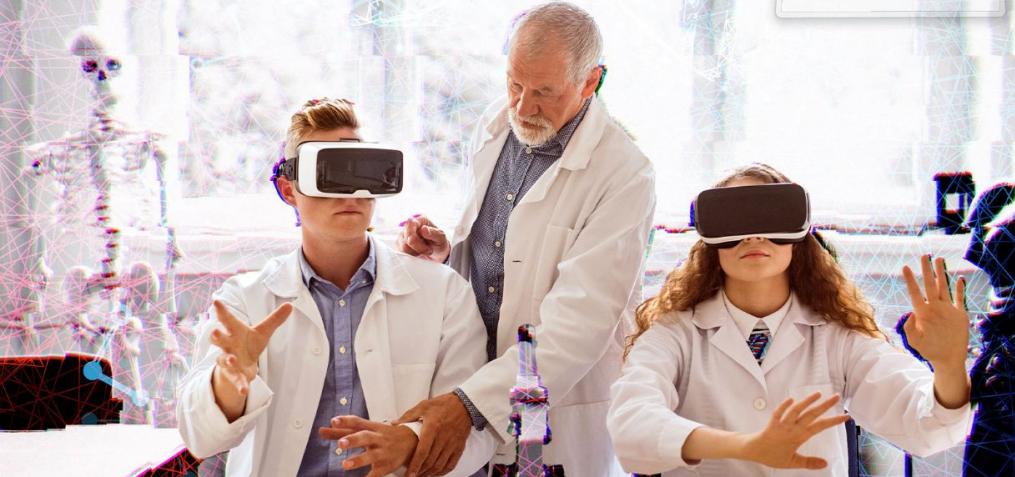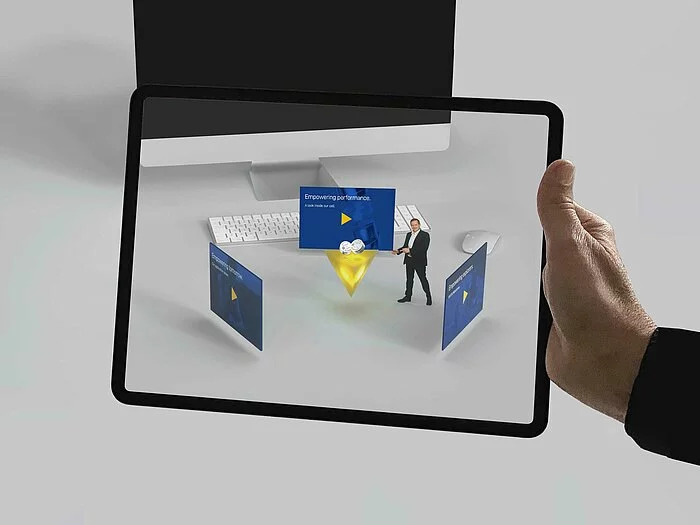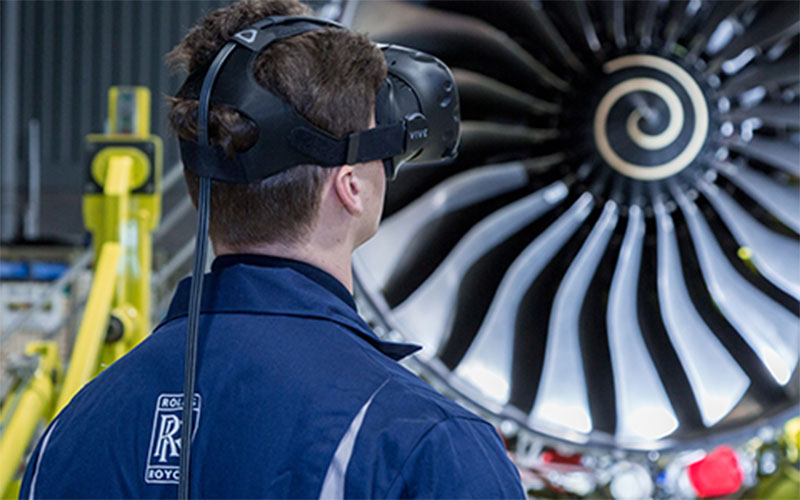In the early ‘90s, psychologist Albert “Skip” Rizzo was trying to rehabilitate cognitive function in brain injury patients with workbooks and pen-and-paper exercises – tools one might expect more from a special education class than a psychiatric treatment center. Then one patient, a frontal lobe-impaired 22-year-old, came in with a Game Boy, playing “Tetris.”
“This is a guy I couldn’t motivate for more than five minutes to stay focused, but there he was lasered in on this Game Boy,” Rizzo recalls. “That was the first lightbulb that we could start using digital technology to motivate and engage people.”
He became one of many medical professionals at the time to recognize the early potential of virtual reality (VR) to help diagnose and treat a wide range of mental health issues. In 1995, Rizzo accepted a research director position at USC’s Institute for Creative Technologies to launch a new kind of cognitive rehab, supplementing the old analog and talk therapy tools with VR simulations.
“Now the technology has caught up with the vision,” he says.
So, what is the vision? Given that most health concerns are inseparable from one’s environment, Rizzo calls VR “the ultimate Skinner box,” meaning it can create safe yet emotionally evocative experiences to serve virtually any assessment or treatment approach imaginable. These therapeutic programs could be uniquely reliable for evaluating patients in the subjective world of mental health, wherein up to 85 percent of conditions can go undetected, according to the World Health Organization.
VR could bridge this gap in awareness and improve diagnoses by letting providers monitor patients’ physiological reactions to virtual scenarios, resulting in better treatment outcomes down the line. At Exeter University, a “mirror game” requiring subjects to duplicate the movements and expressions of a virtual avatar aided early detection of schizophrenia. In a similar vein, University of Oxford researchers are developing a VR-based test that gauges subjects’ reactions to neutral social situations for instances of paranoid thinking. Another study from Cambridge University diagnosed early Alzheimer’s-related spatial impairments more accurately than the current gold standard method, just by having participants don an HTC Vive and retrace their steps along an unmarked L-shaped path.
Another area where VR offers proven advantages is “extinction learning,” a method for overcoming fear and emotional trauma by gradually desensitizing one to the source of their anxiety. Though patients know these experiences aren’t real, that doesn’t change the preconscious response and fear activation of their limbic systems, manifesting in increased heart rate and production of the stress hormone cortisol. Our emotional command centers naturally suspend disbelief even when our logical minds know better, putting VR on par with real-life exposure therapy in clinical effectiveness, but with none of the travel costs or physical danger.
While early programs were calibrated to extinguish common phobias like fear of heights (balancing on a plank between skyscrapers), flying (sitting on the runway in a commercial aircraft) and spiders (progressing through increasingly realistic arachnid encounters), advancements in tech have allowed researchers to tailor more complex experiences, like crowded streets to stimulate social anxiety or traumatic memories for PTSD.
Starting in 2003, Rizzo modified a VR shooter game into an exposure tool called “BRAVEMIND” for veterans to reprocess their traumatic experiences, whether relating to IED blasts or sexual assault, with a therapist virtually recreating the memory as described.
“Most treatments out there for PTSD don’t have a lot of empirical evidence,” explains Rizzo. “The ones that do so far are ones that help a person focus on addressing the trauma, not avoiding it.”
The same principle seems to apply for another trial use of VR to treat schizophrenia. Traditionally, therapists advise patients to ignore auditory hallucinations, but a University of Montreal research team instead helped them create and interact with virtual avatars for the voices in their heads. While four of 19 subjects quit after the first session, the remaining 15 rated each interaction less frightening than the last, and their hallucination-related distress dropped an average of 5 points on a scale of 20 by the study’s end.
More recently, Rizzo and others have taken VR a step further, exploring something increasingly unheard of in American healthcare – prevention.
“BRAVEMIND” was retooled into the award-winning training simulation “STRIVE,” or Stress Resilience In Virtual Environments, preparing military members for the trials and traumas of combat before they’re deployed. Standing atop a vibrating platform in an immersive headset, recruits experience 15-minutes episodes at the midpoint of which an “emotionally challenging” event occurs based on real combat situations, such as the death of a civilian child or beating of a woman for infidelity. The scenario pauses, and a virtual “mentor” pulls players aside to help them process the event and teach physiological coping strategies, like deep breathing with a pair of onscreen lungs.
“We’re trying to engage people in stuff they normally get by way of death by PowerPoint,” says Rizzo. “We know experiential learning with a story sticks in the brain way more than somebody telling you in a lecture.”
Other psychological applications where VR has shown promise include weakening cravings that drive addiction and relapse, reducing body size overestimation in anorexia patients, imparting job interview skills to the autistic or formerly incarcerated, distracting from acutely discomforting procedures like chemotherapy and teaching mindfulness in ways that can engage and offer relief for even chronic pain sufferers. Some VR treatments are already rolling out to clinicians’ offices and consumers – “BRAVEMIND” and “STRIVE” are being donated by the charity SoldierStrong to VA offices across America, while the company Limbix offers $200 monthly subscriptions for a headset with their range of medical-grade VR apps.
Yet this ability to literally shape and heal human minds has mainly been overshadowed by commercial excitement for VR video games, not that Rizzo minds. Gaming industry investment has driven the technology to new heights in sensory immersion and new lows in cost – from $15k for a full setup in the ‘90s to $200 for a standalone headset today – giving it a clinical edge over pricier techniques like neuroimaging.
Now, however, Rizzo considers the incubation period for VR over and stresses the need to distinguish between entertainment versus health-related applications, lest business motives get in the way of credible science and set back public acceptance of the technology. There are many ethical considerations still to be sorted out as well, like ensuring providers have adequate training on the tech as well as patients’ needs and establishing safeguards for self-administered VR treatments.
“We’re not building games here,” Rizzo emphasizes, “we’re building experiences.”
But at the same time, that gaming element may be the key to VR’s revolutionary potential for healthcare. Effective treatment means nothing if people don’t use it, and the allure of VR, demonstrated time and time again in preliminary studies, could actually drive engagement and education in mental health as a whole. Just as the introduction of flight training simulators in the ‘30s led to a precipitous drop in aircraft accidents, this could be another immersive practice tool to minimize real-world distress, but with a universal scope and appeal well beyond that of any Game Boy.
Quelle:
https://vrroom.buzz/vr-news/health-fitness/vr-storytelling-could-transform-mental-health




